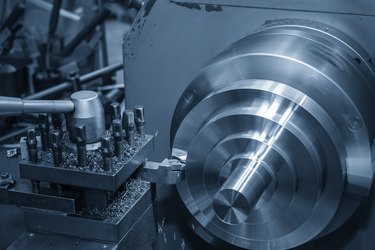
A drill chuck is an adjustable clamp that allows drill bits to be put in and tightened. All drills have these, and they are made to allow the user to switch out the bits as needed for different kinds of projects. The chucks can be adjusted to accommodate the various bits. Some have keys, while newer ones are keyless. Larger chucks can hold larger bits, and the most common sizes are 1/4 inch, 3/8 inch and 1/2 inch.
How Drill Chucks Work
Video of the Day
A drill chuck has several main parts, and these include the sleeve, gear teeth, body, jaws and outside shell. There may also be a ring nut and a key. Chucks with two to four jaws work the same way: The body positions and guides the jaws' movement as they come together and separate. The sleeve rotates around the body, and as that sleeve turns, so does the ring nut. The ring nut's teeth interlock with the jaws' teeth, and the jaws move backward and apart or forward and together as the body guides them.
Video of the Day
The jaws are brought together or separated when the shell on the outside of the chuck moves. If that shell rotates clockwise, the jaws come together to clamp the drill bit in place so that you can use it. When the shell turns counterclockwise, the jaws come apart and release the drill bit so that you can replace it.
Inserting Drill Bits
Most portable drills do not have keys, but some do; these are more often seen nowadays in drill presses. With key chucks, you insert a separate key into the chuck's keyhole. To insert a drill bit using a key, loosen the chuck and slide in the drill bit. Insert the key into the hole, turning it clockwise to tighten or counterclockwise to loosen the chuck. The key must match the chuck exactly; when you first get the drill or drill press, you will want to make sure you don't lose the manufacturer's key.
If you lose that key, it is best to order a new one from the manufacturer that's specifically designed for your drill; otherwise, you could strip the keyhole or chuck. You don't have to worry about this key stripping with keyless chucks; insert the drill bit into the chuck and tighten it. Some of these have two parts; the bottom holds your chuck in place, while you can turn the top to tighten or loosen the bit.
Types of Drill Chucks
Because of how drill chucks are made, you can mount them in different ways. With threaded-mount drill chucks, there is an internal thread that attaches to a threaded arbor (shank) or a power drill spindle. Tapered-mount models have an internal Jacobs taper that's fitted onto a JT spindle or shank. Ones with integral shanks have these built in, and they have more concentricity and rigidity than press-fit tapered mounts.
The bearing type of a drill chuck is also essential to consider because these reduce friction in the closing mechanism, allowing for more grip pressure on the drill bit. The drill chuck that's best for your purposes will depend on the type of work you're doing. A light-duty bearing is suitable for small jobs, and you can use plain bearings for stationary drilling, woodworking machines, milling, turning and medium-duty use. Ball-bearing chucks are best for heavy-duty work but usually require a key.
Installing a Drill Chuck
Always disconnect the drill's battery pack or unplug it before installing a drill chuck. If you have a threaded spindle chuck, open up the jaws all the way and remove the left-hand thread screw if there is one. Insert a hex-type wrench into the chuck's body and tighten the wrench's jaws. Using a mallet, hit the wrench counterclockwise and unscrew the chuck.
Screw on the new chuck, tighten the jaws with the wrench and hit the wrench again with the mallet to tighten things. For tapered shank arbors, clean the tapers thoroughly. Open the jaws until they are retracted into the chuck and place the chuck nose inside. Rest it on a flat surface and hit the tang of the arbor lightly to seal this into the new chuck.